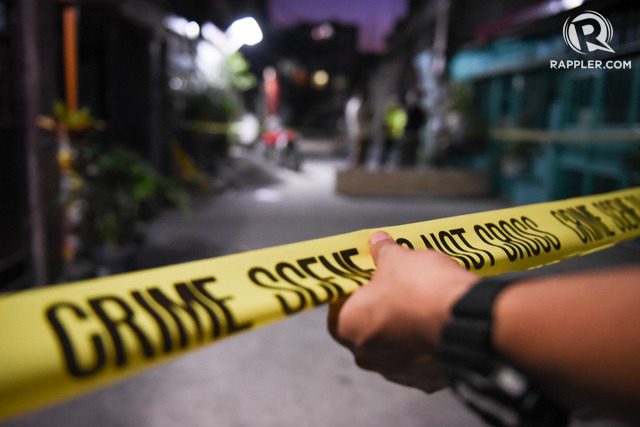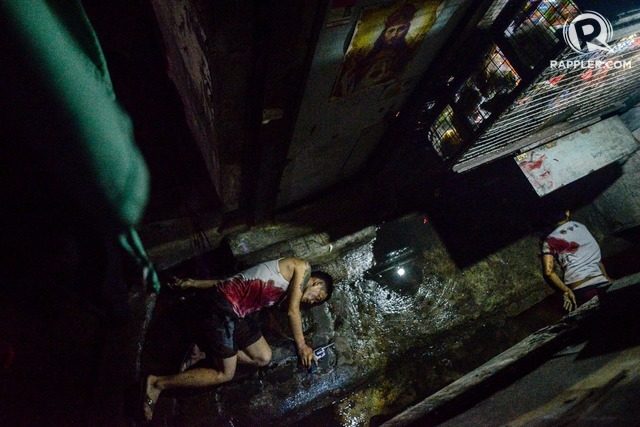SUMMARY
This is AI generated summarization, which may have errors. For context, always refer to the full article.

MANILA, Philippines – For the past weeks, the Philippine National Police (PNP) has conducted so-called “one-time, big-time” (OTBT) operations against illegal drugs and criminality.
Most of these operations ended bloody. In a span of just 4 days of operations in Metro Manila and Bulacan, 81 suspects lay dead.
By the PNP’s own definition, OTBTs are when “all-out police operations are simultaneously conducted against illegal drugs personalities, most wanted persons, loose firearms, and all other forms of crimes.”
These operations are far-reaching and high-intensity, with at least a hundred cops deployed at a time.
The police say those who don’t fight back survive, while those who resist arrest may not be as lucky.
Among those who met a tragic fate is Kian delos Santos, the 17-year-old student from an impoverished neighborhood in Caloocan City who was killed in a drug raid as part of an August 16 OTBT operation.
While Delos Santos has been laid to rest, his case is far from being buried as more and more irregularities in the operation are being unearthed.
Given the controversy, and how police are bent on continuing their operations, Rappler takes a look at the process followed by the PNP.
1. Public perception
It all starts with hearsay.
Cops first gather information through residents who complain to them, or through other informal complaint channels like text lines, social media accounts, or in other neighborhoods, through drop boxes. (READ: CHR: Use of drop boxes in drug war increases risk of mistaken arrest)
According to Makati City police chief Senior Superintendent Gerardo Umayao, they heavily rely on reports on the ground to identify which places to operate in. (READ: On a drug list and innocent? Here’s what you should do)
“Depende po ‘yun sa nakikita naming sitwasyon. Halimbawa medyo maraming resurgence ng drug pusher… Hindi kami namimili kung saan namumugad, ‘yung pinaghihinalaan,” Umayao told Rappler.
(It depends on the situation we see. For example, if there is a resurgence of drug pushers… We do not choose where they operate, where people suspect they stay.)
These complaints don’t have legal weight, but police use these as tips for where they should go. (READ: Cops ‘confirmed’ Kian ‘drug ties’ after operation, through social media)
2. Intel and investigation
From there, police formally gather evidence against suspects, which can be testimonial, documentary, or objects.
Testimonials are sworn accounts or affidavits; documentary evidence are records such as receipts, photographs, and videos pointing to crime; and object evidence are actual objects that are forbidden such as illegal drugs.
In tough cases where police can’t get evidence, assets and informants are hired.
“Merong access sila doon dahil sa pulis ‘di sila magbibigay, hindi makakalapit (They have access to the area because sources don’t give to the police, police can’t go near as well),” Pasig City police chief Senior Superintendent Orlando Yebra told Rappler.
Through their own investigation and informants, police get a clearer picture of the drug and criminality situation. The list of suspects’ names grows longer, containing what they look like, how they group together, who they are associated with, and where they usually operate, among other critical information.
Cops then collate evidence and weigh cases to decide which can be pursued, and which needs more investigation, or as they say, “case buildup.”
3. Warrant requests
Given that all have the right against warrantless search and arrests, cops need to request for warrants from the courts. (READ: Indicted? Charged? A guide to court jargon)
Based on evidence gathered by the police from their assets and intelligence groups, judges decide whether persons implicated by police can really be subjected to searches or arrested.
With search warrants valid for only 10 days, police ask for them in bulk.
“‘Yung search warrant, kung maganda ang statement at intel gathering, kaya makuha ‘yun in one to two days (If the statements and intel gathering went well, we can get search warrants in one to two days),” Yebra said.
The first two stages continue until the police chief of the city or municipality says they have enough suspects for an OTBT operation.
The list of suspects would need to be long enough that it would require at least 100 cops performing the simultaneous operations.
4. Execution
When the police chief decides that they already have enough suspects for an OTBT operation, he or she begins plotting the operation.
Once done, he or she needs to prepare a pre-operation clearance which contains the nature of the OTBT operation, the participating personnel, equipment to be used, and the date of execution.
Some operations last for 24 hours, while some can be as short as 3 hours, depending on difficulty.
On the scheduled date, the police chief conducts a final briefing, and the cops are deployed.
During the operation, police usually divide themselves into groups to cover more ground. Through this, Yebra said, suspects who try to flee can easily be hunted down with other teams stationed in the neighborhood.
In an encounter, police are dictated by rules of engagement, outlined in the PNP’s operations manual.

They must introduce themselves as police before arresting or searching, and they cannot use excessive force unless the situation calls for it.
Ideally, suspects surrender immediately, but if they resist or are violent, police may apply force to capture them, and to defend themselves.
In non-lethal cases, police can use their baton, pepper spray, stun gun, and other non-lethal weapons to subdue suspects.
If the suspect is capable of killing, such as when he or she wields a gun, cops can use firearms for self-defense. (READ: Kian delos Santos tests negative for gunpowder)
The manual explains when self-defense is valid for using guns: “One who resorts to self-defense must face a real threat on his life, and the peril sought to be avoided must be actual, imminent, and real. Unlawful aggression should be present for self-defense to be considered as a justifying circumstance.”
From these encounters, police arrest dozens, and when there are suspects who fight back, they say they are forced to kill. (READ: PNP, PAO agree: Kian kneeling when killed)
With consent, cops also take into custody persons whose names are on the PNP’s crime lists. Cops cannot detain them for too long without a warrant, however, or they will violate Article 125 of the Revised Penal Code.
At the end of the OTBT operation, all team leaders of the individual operations prepare spot reports, then the police chief compiles these into one report.
5. Investigation and persecution
Regularity is presumed in all police operations, but in instances when there are doubts or questionable circumstances, investigations follow.
If police shoot in an operation, the PNP Internal Affairs Service (IAS) conducts a motu proprio investigation or probes that they independently decide to pursue.
Should cases be elevated to murder or homicide, the PNP can also mobilize its Criminal Investigation and Detection Group (CIDG).
In cases where police may have violated human rights, the Commission on Human Rights (CHR) can launch an investigation.
Administrative charges are filed by the PNP-IAS with permanent dismissal as the worst punishment, while the rest can file criminal charges that can put cops behind bars.
A creature of the past, adopted

“One-time, big-time” operations are not new to the PNP.
As mentioned by PNP chief Director General Ronald dela Rosa during the Senate hearing on Delos Santos’ case, these operations started during the Aquino administration.
“Almost the same mechanics… itong commanders ko inadopt na lang nila (It’s almost the same mechanics… my commanders just adopted it),” Dela Rosa said in response to a question from Senator Panfilo Lacson, himself a former PNP chief.
Before Project Double Barrel came Oplan Lambat-Sibat – also a two-tier plan like Project Double Barrel— devised by former interior secretary Manuel Roxas II.
The OTBT operations are under the Lambat (Dragnet) side, where small-time suspects are massively caught like a net catching fish. It is akin to the lower barrel aspect of Double Barrel where police conduct operations against suspected small-time drug pushers and dealers.
The Sibat (Spear) side comprises of focused and targeted intelligence operations against influential criminals, likened to spearfishing. It rings of Oplan High-Value Target – the upper barrel of the Duterte administration’s campaign which targets drug lords.
The difference lies in the crimes being targeted. Lambat-Sibat was for all crimes, while Double Barrel specifically aims to curb the drug menace. Since President Rodrigo Duterte sees drugs as the root of all crimes, much of the PNP’s energy goes to the unrelenting war on drugs.
Amid the bloody drug war, all crimes dropped during Duterte’s first year, except for killings. – Rappler.com
Add a comment
How does this make you feel?
There are no comments yet. Add your comment to start the conversation.